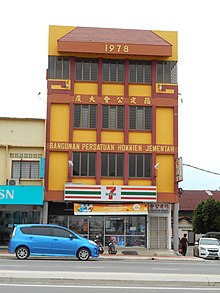This article or section possibly contains synthesis of material which does not verifiably mention or relate to the main topic. (January 2011) |
This article needs additional citations for verification. (January 2022) |
Southern Malaysian Hokkien (simplified Chinese: 南马福建话; traditional Chinese: 南馬福建話; pinyin: Nán Mǎ Fújiànhuà; Pe̍h-ōe-jī: Lâm-Má Hok-kiàn-oē) is a local variant of the Min Nan Chinese variety spoken in Central and Southern Peninsular Malaysia (Klang, Melaka, Muar, Tangkak, Segamat, Batu Pahat, Pontian and Johor Bahru). Due to geographical proximity, it is heavily influenced by Singaporean Hokkien.
| Southern Malaysia Hokkien | |
|---|---|
| 南马福建话 Lâm-Má Hok-kiàn-oē (POJ) | |
| Native to | Southern Malaysia |
| Region | Johor and Malacca |
Early forms | |
| Dialects |
|
| Language codes | |
| ISO 639-3 | nan for Southern Min / Min Nan (hbl for Hokkien Bân-lâm is proposed[4]) which encompasses a variety of Hokkien dialects including "in Malaysia, most notably in and around Kuching, Muar, Klang".[5] |
| Glottolog | None |
| Linguasphere | 79-AAA-jek |

This dialect is based on Quanzhou-accented varieties of Min Nan, including the Eng Choon (Yongchun) dialect.[6][7] It is markedly distinct from Penang Hokkien and Medan Hokkien, which are based on the Zhangzhou dialects.
Similar to the situation in Singapore, the term Hokkien is generally used by the Chinese in South-east Asia to refer to Min Nan Chinese (闽南语). Southern Malaysian Hokkien is based on the Quanzhou dialects with some influence from the Amoy dialect. The dialect also contains loan words from Malay.
Phonology edit
This section is based on Eng Choon (Yongchun) Hokkien spoken in Melaka.[8][9]
Vowels edit
There are eight phonemic vowels:[7]
| Front | Central | Back | |
|---|---|---|---|
| Close | i | ɨ | u |
| Close-mid | e | o | |
| Mid | ə̠ | ||
| Open-mid | ɔ | ||
| Open | a |
Tones edit
There are seven tones, five of which are long tones and two are checked tones.[6] Like other varieties of Hokkien, these tones also undergo tone sandhi in non-final positions.[6] The tone values (both base tones and sandhi tones) of the long tones are shown below:[10]
| Tone number | Final/base tone | Non-final/sandhi tone |
|---|---|---|
| 1 | ˧ (33) | ˧ (33) |
| 2 | ˨˧ (23) | ˨˩ (21) |
| 3 | ˥˨ (52) | ˧˦ (34) |
| 5 | ˨˩ (21) | ˥˧ (53) |
| 6 | ˨˩ (21) | ˨˩ (21) |
Influences from other languages edit
Southern Malaysian Hokkien is also subjected to influence from various languages or dialects spoken in Malaysia. This is influenced to a certain degree by the Teochew dialect and is sometimes being regarded to be a combined Hokkien–Teochew speech (especially in Muar, Batu Pahat, Pontian and Johor Bahru).[citation needed]
There are some loanwords from Malay, but they are fewer in number than in Penang Hokkien and do not completely replace the original words in Hokkien.[11] It also has loanwords from English.[citation needed]
Notes edit
References edit
- ^ Mei, Tsu-lin (1970), "Tones and prosody in Middle Chinese and the origin of the rising tone", Harvard Journal of Asiatic Studies, 30: 86–110, doi:10.2307/2718766, JSTOR 2718766
- ^ Pulleyblank, Edwin G. (1984), Middle Chinese: A study in Historical Phonology, Vancouver: University of British Columbia Press, p. 3, ISBN 978-0-7748-0192-8
- ^ Hammarström, Harald; Forkel, Robert; Haspelmath, Martin; Bank, Sebastian (2023-07-10). "Glottolog 4.8 - Min". Glottolog. Leipzig: Max Planck Institute for Evolutionary Anthropology. doi:10.5281/zenodo.7398962. Archived from the original on 2023-10-13. Retrieved 2023-10-13.
- ^ "Change Request Documentation: 2021-045". 31 August 2021. Retrieved 30 May 2022.
- ^ "Reclassifying ISO 639-3 [nan]" (PDF). GitHub. 31 August 2021. Retrieved 28 July 2022.
- ^ a b c Chang & Hsieh 2012, p. 38.
- ^ a b Huang, Chang & Hsieh 2011, p. 914.
- ^ Huang, Chang & Hsieh 2011.
- ^ Chang & Hsieh 2012.
- ^ Chang & Hsieh 2012, p. 43.
- ^ Tan 2001, p. 218.
Sources edit
- Chang, Yueh-chin; Hsieh, Feng-fan (2012). "Tonal coarticulation in Malaysian Hokkien: A typological anomaly?". The Linguistic Review. 29 (1): 37–73. doi:10.1515/tlr-2012-0003.
- Huang, Ting; Chang, Yueh-chin; Hsieh, Feng-fan (17–21 August 2011). An Acoustic Analysis of Central Vowels in Malaysian Hokkien (PDF). 17th International Congress of Phonetic Sciences. Hong Kong. pp. 914–917.
- Tan, Chee Beng (2001). "Chinese in Southeast Asia and Identities in Changing Global Context". In Armstrong, M. Jocelyn; Armstrong, R. Warwick; Mulliner, Kent (eds.). Chinese Populations in Contemporary Southeast Asian Societies: Identities, Interdependence and International Influence. London and New York: Routledge. pp. 210–236. ISBN 0-7007-1398-0.